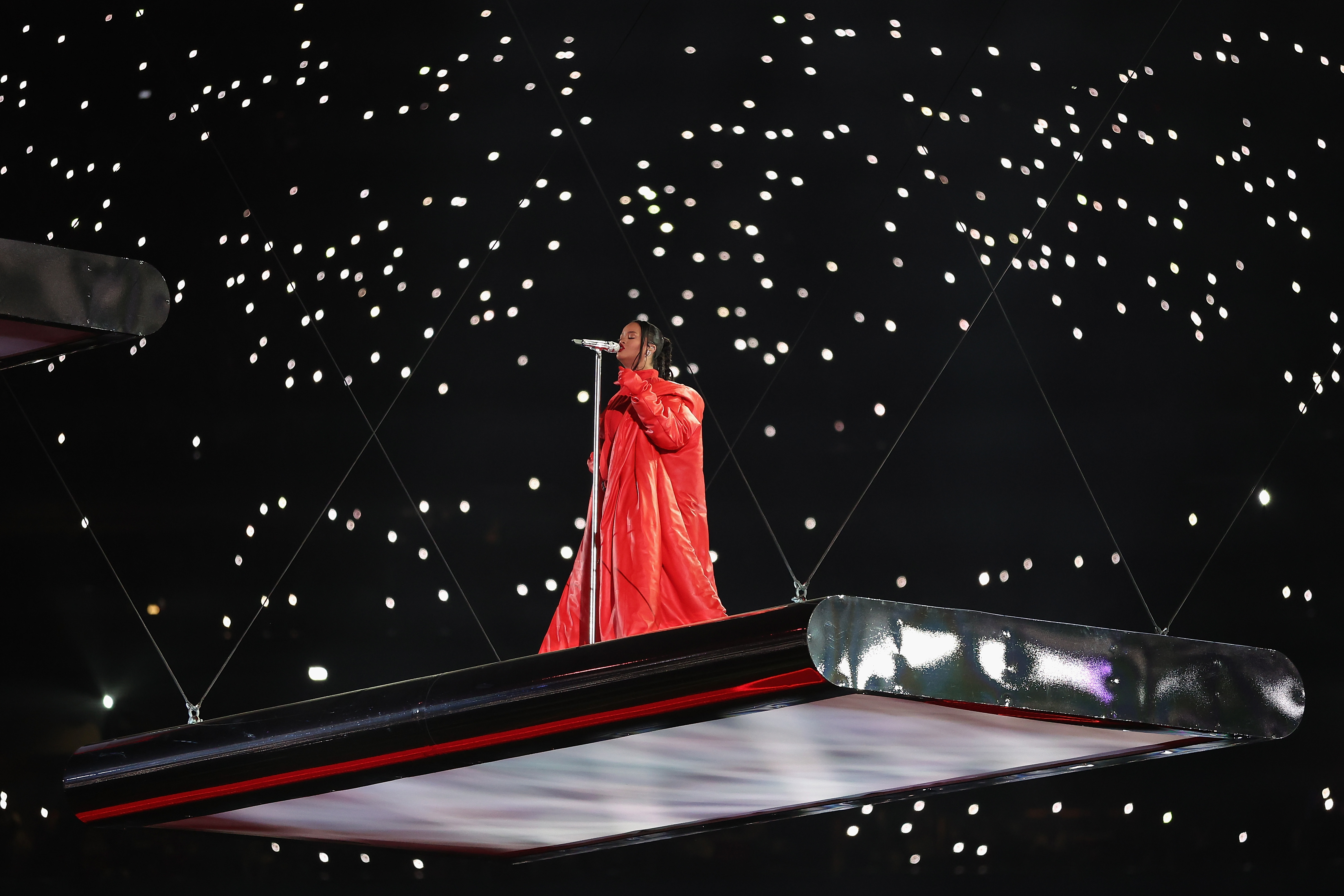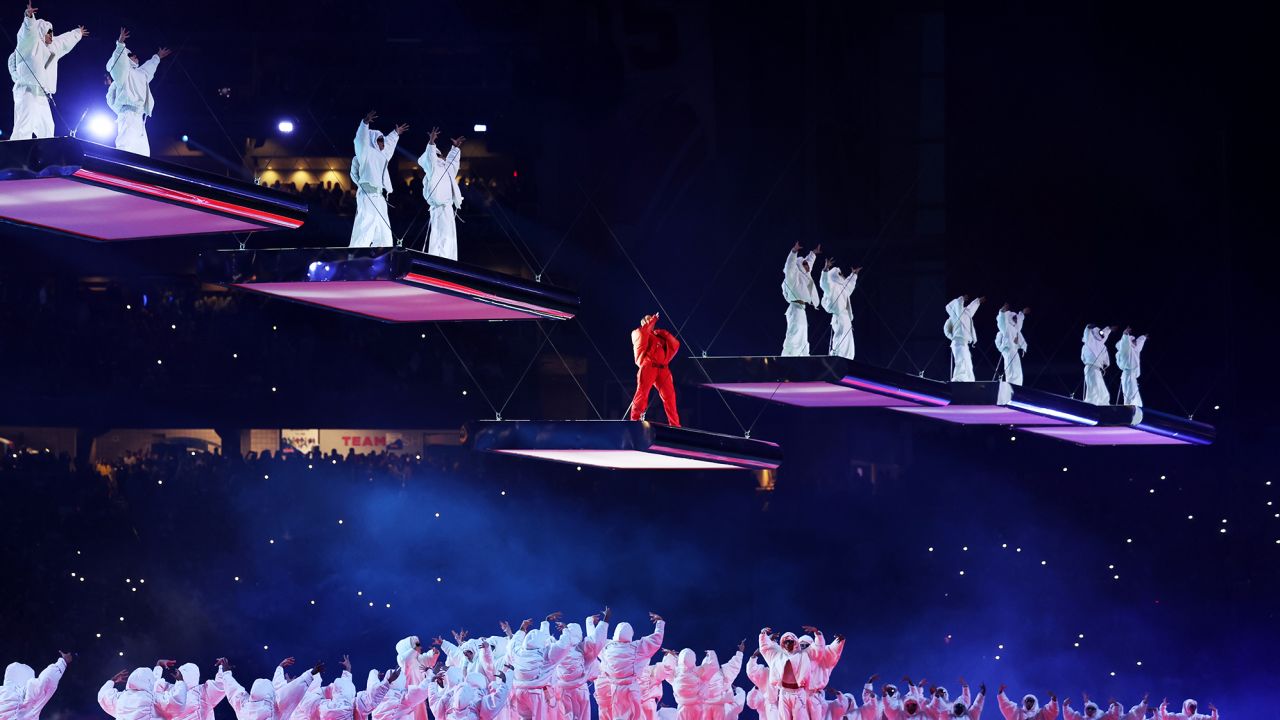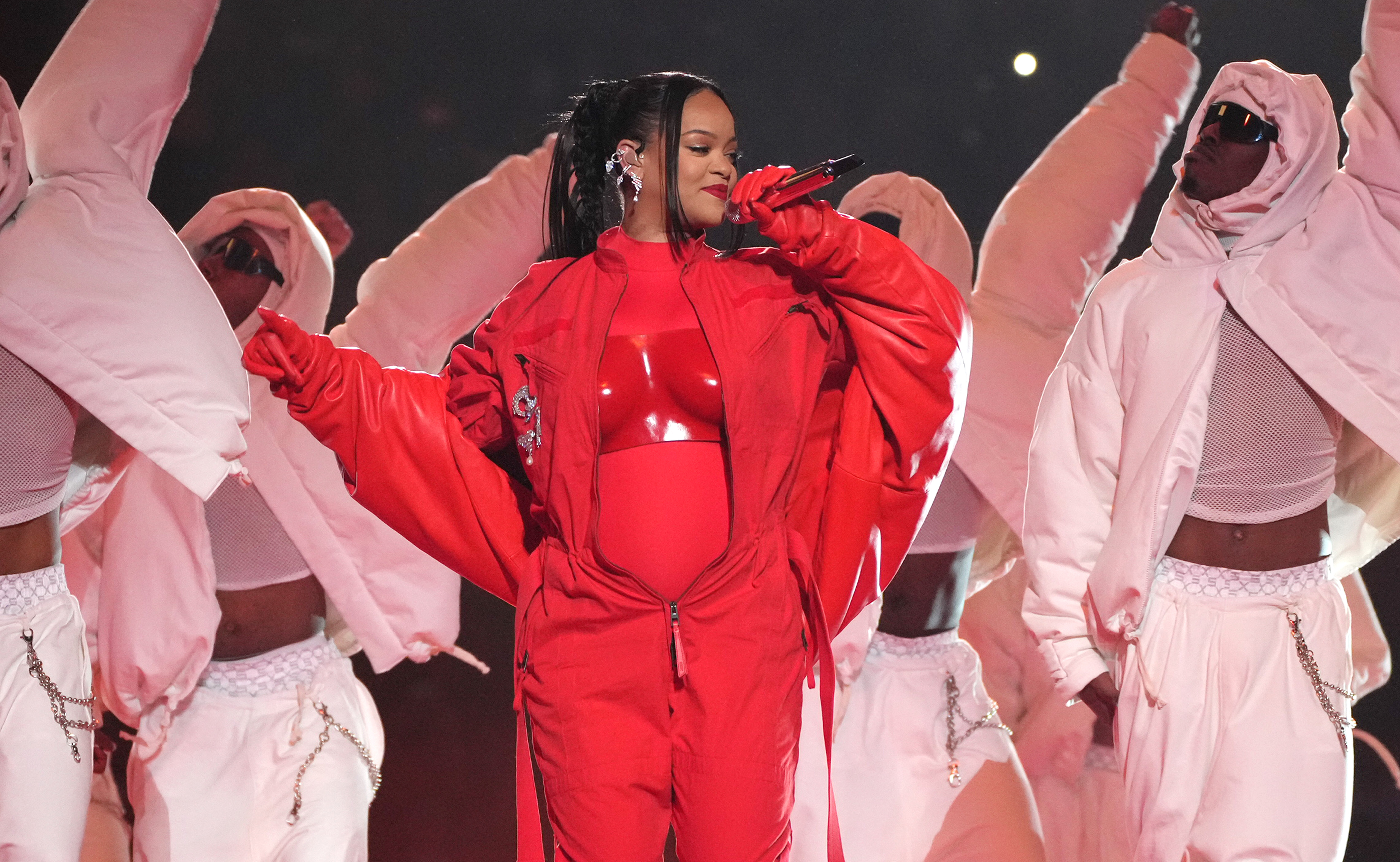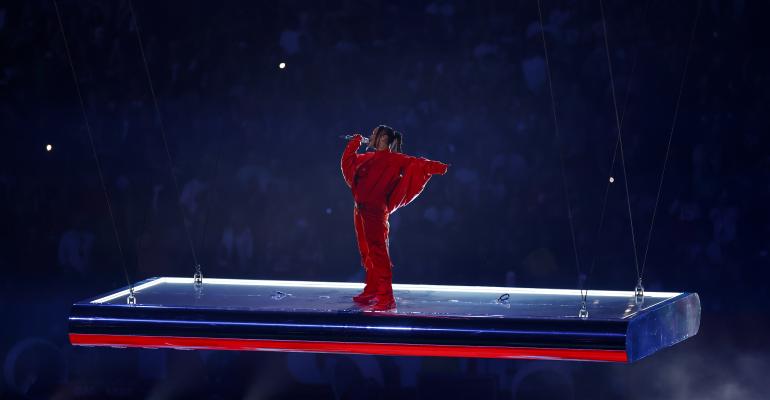For football and RiRi fans alike, the Super Bowl LVII Halftime show a few weeks ago was about the return of the Grammy award-winning singer and the annual excitement of the performance reveal. But for stage designers and event producers, this year’s Halftime performance drew attention for a different reason: seven never-been-done-before floating platforms that carried the singer and her dancers.
These platforms allowed Rihanna and several dancers to move vertically across the air throughout the performance. And while it seems like the stunning visual effect would be reason enough for the design, there was a more functional motivation for the air-lifted performance: protecting the field’s grass.
State Farm Stadium is covered with Tifway 419 hybrid Bermuda grass, an attempt to reduce injuries that are caused by impact with traditional turf. Putting a massive stage on that grass can potentially alter the GMAX rating, which measures the hardness of a surface. Thus, stage designers looked toward the air.
Super Bowl Halftime producer Bruce Rogers of Tribe, Inc. let Rihanna and her team know the limitations of the grass field, and for the sake of a bigger and better show, suggested a performance suspended in the air. State Farm Stadium has a dome with huge Brunel trusses that are, as Rogers put it, “strong enough to carry a freight train.” Rihanna and her team were in.
“This has never been done before,” Rodgers said in an interview with Wired. “With Katy Perry, we flew her around in a flying device, like a rocket ship. But this one is a totally different animal.”
Staging

All Access Staging & Productions was put to the task of building out the set. The platforms, roughly 10 by 17.5 feet each, were stored in those tresses during the first half of the game, then guided down to the field on synthetic cables using automated motors. Rihanna and her dancers were clamped onto the platforms with a retractable bungee cord of sorts. Throughout the show, each platform moved anywhere from 15-60 feet off the ground.
“This will be, in my opinion, the most technically advanced Super Bowl halftime show that’s ever been done because of the amount of tech used to move the platforms,” said Aaron Siebert, the project lead from Tait Towers, who made the platforms.
But the floating platforms weren’t the only challenge. There was also the matter of the stage itself, which stretched the length of the field. The stage was constructed out of 23 rolling structures (called “carts”). Each cart ranged from 10 by 24 feet to 8 by 31 feet, weighing anywhere from one to two tons apiece. To protect the grass, the NFL limited the number of carts on the field to 25; All Access ended up with 23 total carts: 14 for the stage and runway system, eight for lighting, five for the main center stage, four for the runway, and one for the end cap.
Each cart was designed with special tires (236 tires total) designed to roll gently and evenly over the grass, as well as 64 sets of stairs that hinged up, keeping everything contained while maximizing each cart’s total square footage. Additionally, every part that touched the ground was reinforced with Enkamat turf protection material.
“You don’t want to have a player taken out of the game on concussion protocol because we left hard spots on the floor,” said Tommy Rose, All Access’ staging supervisor. “We are really mindful about that.”
The carts were too wide for the stadium’s house ramp, so to roll the carts onto the field, All Access created a custom field access ramp, 14 feet wide and 62 feet long.

Photo courtesy Ezra Shaw via CNN
All of this was laid out ahead of time in a full-scale replica set in a different Phoenix arena for artist rehearsals. During the actual show, the crew had about seven and a half minutes to set up everything and six to tear down. Overall 16 semi-trucks were used to haul equipment, and over 800 people were involved, from camera operators to stage crews, to Rihanna and her 80 dancers and seven band members.
Lighting & effects
With so many moving parts, lighting had to be designed in a way that worked with the show. The bottom of each platform was fastened with 512 lights, which were choreographed to match Rihanna's performance. The stage and runway were also lined with RGBW LED tape as well as four rows of LED strips. Overall, about 4,000 feet of LED lighting was used, which utilized over 12,000 feet of wire.
Pyrotechnics came into play midway through the show with a fireworks display from Pyrotecnico. There were also supposed to be 44 high-intensity Atlas fog generators, although these didn’t make it into the final cut of the show.
Design

Part of what made the performance so visually appealing was the balance of complex stage mechanics alongside a simple color scheme.
Rihanna was dressed in all red, matching the stage, while all of her performers were dressed head to toe in white. This color scheme was designed by Canadian designer Willo Perron, who creates showpieces for several artists, including Drake, Tame Impala, Jay-Z, and Rihanna’s fashion brand Savage X Fenty.
“The main stage is this UV red with safety orange staging—I thought it would be nice to do something that’s brutally present and explodes,” said Perron in an interview with Wallpaper. “The flying platforms are all chrome which is great for picking up light—I wanted this to feel almost like a contemporary furniture piece.”
The perfect shade of red was finally chosen after narrowing down about 15 options, with designers settling on premium luminescent Wildfire paint color Bright Red.
“I thought about the audience for this—obviously a lot of Rihanna fans, and then America’s football fans,” said Perron. “I wanted the materiality and color scheme to employ a sort of American vernacular by means of transport: chrome reflecting the bumpers on vehicles, red and orange schematics representing iridescent roadway signage.” Overall, it took 57 gallons of paint to cover the stage.
Looking forward
As more stadiums convert from turf to grass, these kinds of considerations will become normal for Halftime show producers. Phil Bogle, the NFL’s director of game operations, says that lighter carts and flying platforms might become the norm, pointing to next year’s Super Bowl location, Allegiant Stadium near Las Vegas—another stadium with a grass field—as an example of the possible future standard.
Leading people and companies:
- Event Producer: Dave Meyers, DPS
- Producer/Director: Hamish Hamilton
- Executive Producer/Director: Shawn Carter
- Executive Producer/Co-Director: Desiree Perez, ROC NATION
- Associate Director: Cameron Whitelaw
- Executive Producers: Jesse Collins, Jay Brown, Roger Goodell
- Co-Executive Producer: Dionne Harmon
- Produced by ROC NATION, Diversified Production Services, Jesse Collins Entertainment
- Design Concept by Willo Perron and Rihanna
- Creative Direction and Production Design: Bruce Rodgers
- Art Direction: Shelley Rodgers, Lindsey Breslauer, Maria Garcia, Lily Rodgers
- Art Department: Regan Eastland
- Lighting Design: Al Gurdon
- Field Staging Design and Engineering: ALL ACCESS, Erik Eastland, Tommy Rose
- Flying Platform and Navigator Camera design and engineering: TAIT TOWERS, Aaron Siebert, Erick Fields, Paul Sapsis, Kiel Heerding
Above information courtesy of the following:
Go Behind-the-Build with All Access: Super Bowl LVII Halftime Show
Super Bowl LVII Halftime Show: Staging Sketches & Credits





